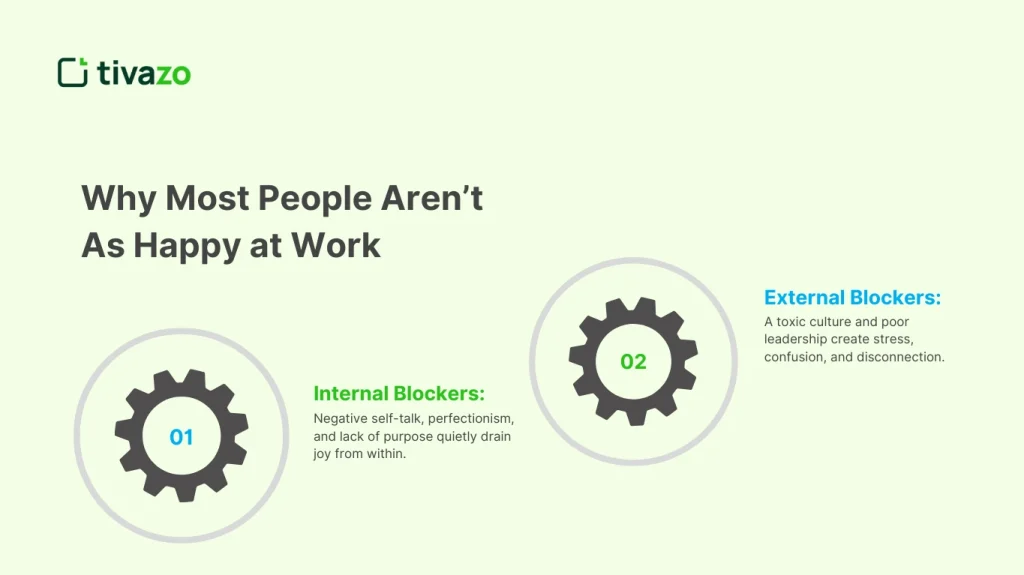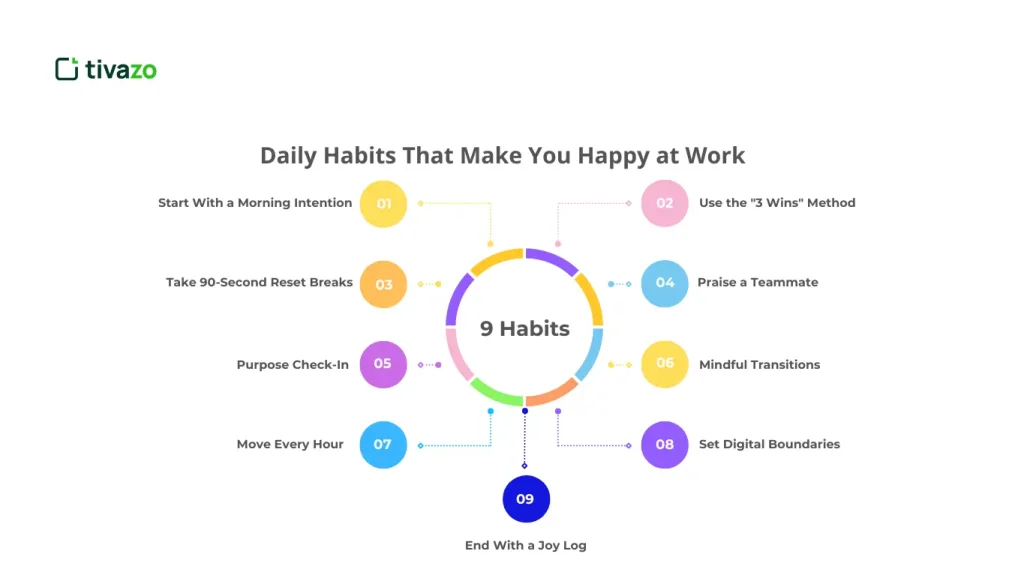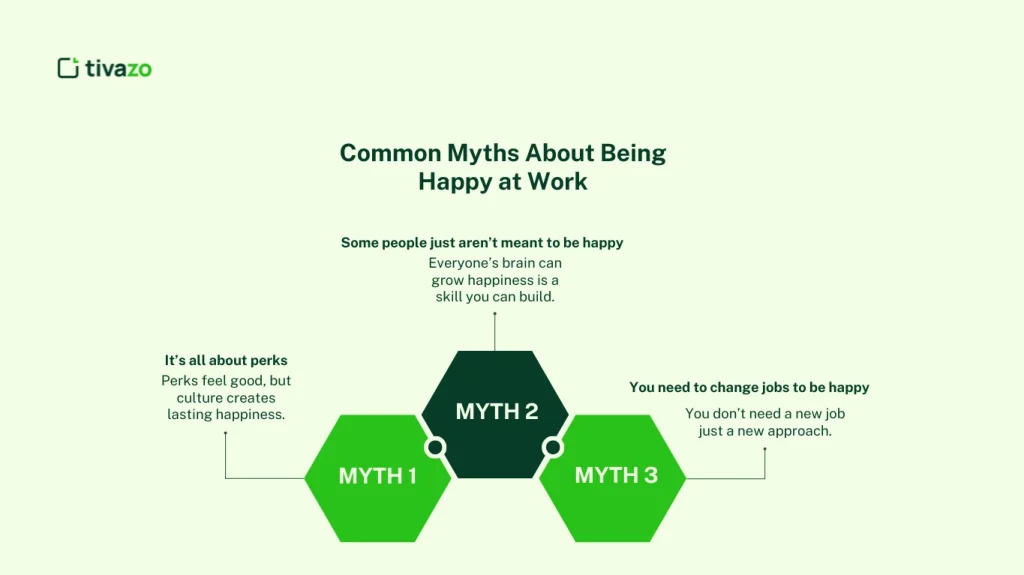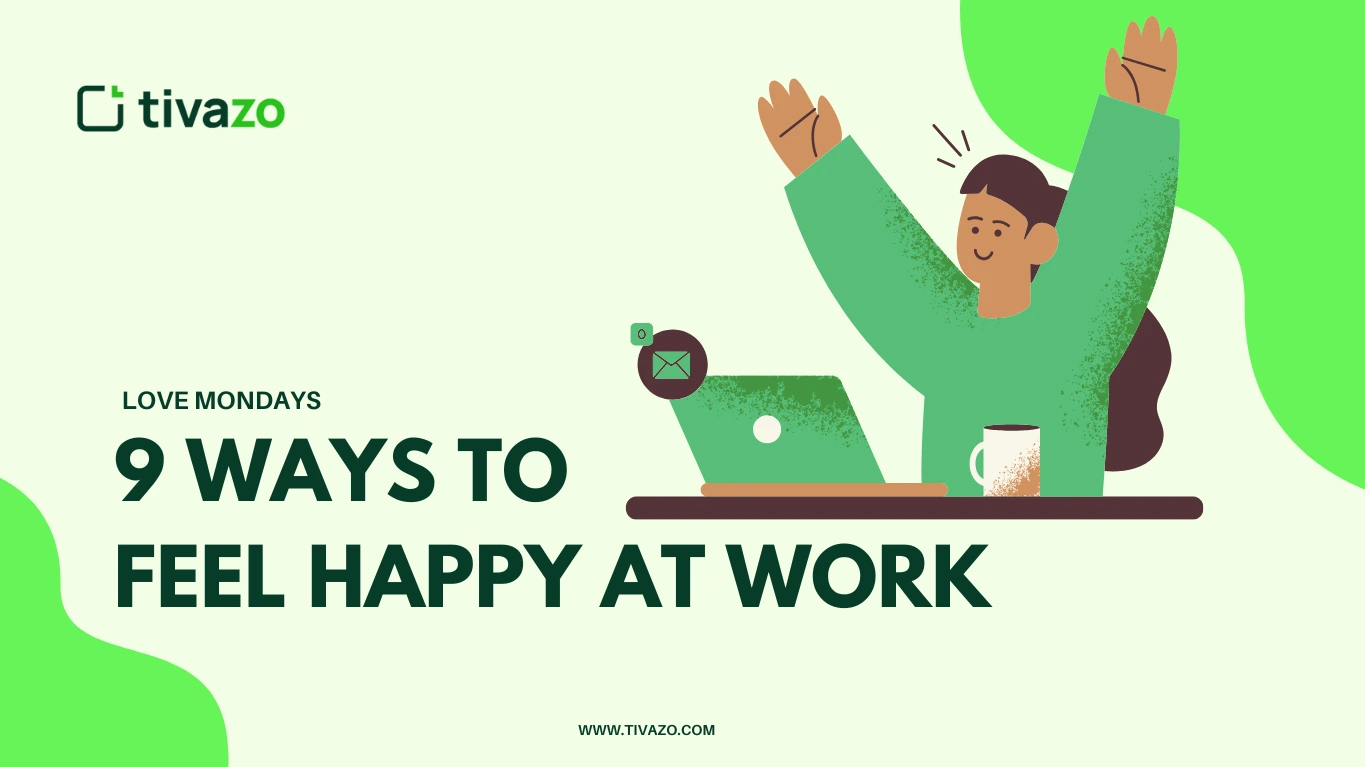Being happy at work isn’t about ping-pong tables and snacks. It’s about feeling emotionally nourished, cognitively revitalized, and socially connected in what has become a hot-burning-dumpster of a world. We spend more than one-third of our lives working, and if that time feels empty, the price for our overall happiness is enormous.
According to Gallup, a mere 23% of workers around the world feel engaged with their work. Which means most people are 8+ hours a day disengaged from meaning.
But what if work didn’t have to be like this?
This guide is here to help you feel more aligned and energized and, yes, genuinely happy at the office.
Key Highlights:
- What Does It Mean to Be Happy at Work
- Why Most People Aren’t As Happy at Work As They Could Be
- 9 Daily Habits That Make You Happy at Work
- Common Myths About Being Happy at Work
What Does It Mean to Be Happy at Work?
Being happy at work isn’t simply about not hating Mondays. It’s about:
- Emotional satisfaction: You feel respected, appreciated, and at peace.
- Mental stimulation: It challenges, but does not go overboard.
- Social belonging: It challenges, but does not go overboard.
- Professional growth: You’re learning, contributing, and progressing.
You don’t need to love all of the tasks you do, but you should love being who you are at work.
Why Most People Aren’t As Happy at Work As They Could Be
You may wonder how to improve happiness at work. Two primary kinds of blockers prevent people from finding happiness at work: internal and external.

- Internal blockers come from within negative self-talk, perfectionism, and a lack of a clear purpose. These are heavy and tough mental burdens. Beliefs such as “I’m not good enough” or “It has to be perfect” decrease the motivation and joy in life. Work without purpose is empty, and happiness is hard to find.
- External blockers stem from the environment, toxic workplace culture, unclear roles, and poor leadership. A hostile or confusing workplace drains trust and leaves one disillusioned. Motivation wanes when leaders micromanage or don’t support their teams.
Many laborers get sucked into the invisible burnout trap, where people appear at work physically, but feel mentally spent. Harvard Business shares that chronic stress kills creativity and emotional intelligence , key components of happiness in the workplace.
The only thing that will make you truly happy at work is if you resolve these two internal wars and external battles. Practicing self-compassion, engaging in deep work, and working in a supportive environment can break the cycle and unlock sustainable joy and these are job satisfaction reasons.
9 Daily Habits That Make You Happy at Work (Backed by Science)
These science-based habits subtly rewire your day — and your brain.

1. Start With a Morning Intention
Place a feeling on your day. Before you dive into emails or drop into meetings, spend a short moment ‘shaping’ a feeling for your day. Perhaps it’s peace, or confidence, or clarity. This is not about putting together a to-do list, but about framing your mind. When you hit a wall and things don’t go your way, your chosen feeling is the compass that keeps you in the centered place, the calm and collective place, and not the reactive place. It is an easy way to direct your emotional energy as opposed to being run by it.
2. Use the “3 Wins” Method
Instead of tasks, list three small wins you want to have emotionally or purposefully. These could be things like: “I want to say something that energizes a teammate,” or “I want to leave a meeting feeling good.” This transforms your day from task-chasing to meaning-seeking and makes work something from which you actively produce joy. And by concentrating on feelings, you can better celebrate progress.
3. Take 90-Second Reset Breaks
Every 90 to 120 minutes, take a 90-second break from what you are doing. Close your eyes, breathe deeply, and just be there, no phones or other distractions. This micro-reset declutters your mind, relieves you of stress you’ve been carrying, and recharges your focus.” Consider it a mini-vacation for the brain — fast but supercharged. It staves off fatigue and allows energy levels to remain relatively stable all day long.
4. Praise a Teammate
Every day, sincerely tell someone like a coworker, your boss, maybe a client, something you would be happy to have said about you. This simple behavior releases serotonin, a brain chemical that increases happiness and strengthens social connections. There’s a ripple effect: your comment makes someone else’s day and, in turn, boosts your mood. Happiness is infectious.
5. Purpose Check-In
Take a moment in your day to ask yourself: “Why does this work matter today?” It doesn’t need to be profound — it could be getting your team working smoothly, mastering something new, or taking care of a client in the right way. Linking your work to a motive, however small, can drive motivation and make mundane tasks meaningful.
6. Mindful Transitions
When you shift tasks or start a new meeting, take a breath and reset your mental setting. Ask yourself: ”How do I want to show up next? This break gives you a chance to put the frustration or distraction from the last period of 25 minutes behind you. It is the mental equivalent of a reboot, and instead of being reactive with your next attempt, you can approach it focused and intentional.
7. Move Every Hour
Sitting still for long periods sucks your energy and dulls your thinking. Every hour or so, stand up, stretch your legs, take a walk , or do some shoulder rolls. Just five minutes of movement can improve blood circulation, stimulate creativity, and make you more aware of your physical self. Even little cracks have an outsized effect on lifting your mood and improving your productivity.
8. Set Digital Boundaries
The dings of notifications and emails can splinter your focus and bring you stress. Guard your attention by turning off unnecessary notifications, trimming back your email checks, and setting aside focused blocks of time for deep work. You can more easily drop into a flow state when you are the master of your digital domain, which can reduce overwhelm and increase satisfaction.
9. End With a Joy Log
Spend a few minutes at the end of your workday capturing one joyful or meaningful moment. It might have been a nice word from a colleague, figuring out a thorny problem, even just a quiet coffee break. It teaches your brain to scan for positivity, and builds the mental proclivity to mind-see more good in your life. In time, it re-focuses you from stress to gratitude, and happiness becomes a natural part of your work life.
The Science Behind Feeling Happy at Work
Being happy at work is not just a nice-to-have; it’s a biological and psychological powerhouse that impacts how well we perform, how well we connect with others, and how much we grow.
Your Brain’s Happy Chemicals: The Real Drivers
- Dopamine: Sometimes referred to as the “motivation molecule,” dopamine helps drive you to draw up a list of goals, figure out how to solve your problems, and celebrate those solutions. When it’s running, you feel energized and focused. This isn’t just about going after rewards; it’s a matter of getting rewarded with little victories all the time in your day to keep your brain active and excited to achieve.
- Serotonin: That is the chemical that balances you and sets the mood. It helps you feel calm, confident, and resilient even when things at work get challenging. With steady serotonin levels, you’re more able to keep from getting overwhelmed or anxious, and to think and respond positively with the people you work with.
- Oxytocin: Often called the “cuddle hormone,” oxytocin helps to create trust and advance social connections. At the office, oxytocin is released when you share appreciation, coöperate, or feel that others support you. It’s the glue that turns groups of people into unified, joyful teams.
Does Being Happy at Work Make You More Productive?
Yes, and it has a very significant effect on productivity, and these are the benefits of being happy at work. After many years and many studies, we’ve discovered that being happy at work not only feels good; it is associated with tangible business results.
What the Numbers Say
- 31% More Productive: A happy employee can do more in less time. Their focus is higher, which means that they finish work products faster and with better quality.
- 3x More Creative: Happiness breeds creativity. When your brain is not exhausted by stress or negativity, it can create new connections, generate out-of-the-box solutions, and ultimately come up with new ideas that might propel your work further.
- 87% Less Likely to Quit: Employee happiness factors into turnover as well. If an employee feels heard, respected, and valued, they are likely to stay longer. This cuts down on turnover time and money for companies and increases the cohesive strength of the team.
Common Myths About Being Happy at Work
It seems that many are labouring under some misconceptions about workplace happiness that are practically keeping them chained down, believing happiness at work is unattainable. Let’s dive into some of the most common myths and the truth behind them:

Myth 1: “It’s all about perks.”
Free coffee, casual Fridays, and flashy office snacks are misleading happiness creators; alone, they are not. “You may wonder do perks make people happy at work. Perks are fine for comfort, but they’re superficial and Band-Aid-y. There are other factors, of course, that lead to happiness: great colleagues, a sense of purpose, and those generous perks. But what really makes people happy is culture — a workplace where people respect, trust, and care about one another. Culture is what determines everyday experiences, in a way that perks never can. When culture is great, employees feel a real sense of belonging and motivation that no latte can produce.
Myth 2: “Some people just aren’t meant to be happy.”
This myth would have you believe that being happy at work is either a trait you’re born with or not. But science tells another story. Our brains can change, flourish, and adapt over time, thanks to neuroplasticity. This implies that habits and mindset, as well as emotional responses, are changeable. Thanks to purposeful practices, anyone can increase workplace well-being by rewiring their brain towards positive thinking, resilience, and engagement.
Myth 3: “You need to change jobs to be happy.”
Some people are convinced that the only way to find happiness at work is to quit their current job. But in most cases, a new perspective or approach can produce a whole new experience. That might include getting clarity on your purpose, deepening relationships, establishing healthy boundaries, or developing daily habits that bring you joy. Sometimes it’s less about where you work, and more about how you work, and connect, in your workplace.
Are You Truly Happy at Work? (Mini Quiz)
Sometimes, it can be difficult for us to really know how we feel about our work until we take the time to stop and think about it. This short, five-question quiz is meant to be an easy gut-check that prompts you to reflect honestly on how you feel about your work. This is not a pass/fail; it is about seeing what in our life is working and what could use some attention. Respond to these questions with your gut reaction, and you may have a clearer picture of your mental and career health on the job.
- Do I feel respected here?
- Do I look forward to anything during my work day?
- Do I feel emotionally safe?
- Am I developing or learning in any way?
- Do I feel valued by this team?
What to Do If You’re Not Happy at Work Right Now
Here’s your 3-step guide for how to become happy at work:
- Own your space – Start small with a habit change
- Look around you – Are your values kneeling?
- When to act – Speak to your manager or discover other avenues
The Hidden ROI of Being Happy at Work
Workplace happiness isn’t merely a pleasant-to-have feel-good; it yields tangible, measurable results to individuals and companies. When you make happiness your priority, you will often sleep better and wake up with more enthusiasm to apply to both your professional and personal life. This newly found energy boosts your immune system, making you more resistant to sickness.
Happier employees also form deeper, more lasting connections with their colleagues, establishing support networks that help drive collaboration and satisfaction. For businesses, these personal positives add up to powerful organisational positives: greater staff retention, lower levels of sick days, and a flood of innovation fed by engaged, motivated teams. All of this emanates from one central change, making happiness a priority—for well-being, yes, but also for long-term success and growth.
Final Thought: The Future Belongs to the Happy at Work
Waiting for other people’s permission to fill your work with meaning? It doesn’t have to be the perfect job, the perfect boss, the perfect environment.” What does matter is having a clear vision of what happiness in work looks like for you and making a few small and kind but deliberate shifts each day in how you’re working with and relating to yourself.
Happy work isn’t about constant excitement or dramatic transformation — it’s about choosing to view work as a source of energy, purpose, and growth, rather than a place to check items off your list. To them goes the future of work: for those who comprehend this truth and take small, habitual steps toward infusing joy into the work that they do. So don’t wait for the perfect time — start today, and start small, but start. A more joyful and vibrant work life is on the other side.
FAQs
How do you say you are happy at work?
You feel respected, enjoy what you do, and end most days with a sense of purpose.
What makes you feel happy at work?
Supportive culture, meaningful tasks, appreciation, and a sense of progress.
How to be happy at your work?
Start small: set daily intentions, build positive habits, and connect with purpose.
How can I improve my workplace happiness naturally?
By using rituals like intention setting, praise, mindful transitions, and movement.




